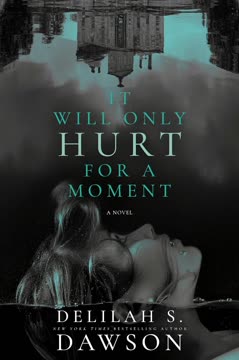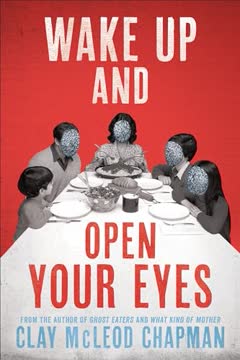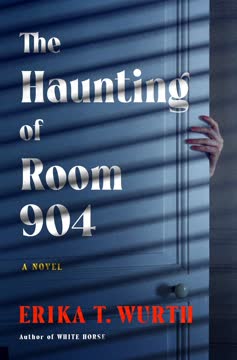Plot Summary
Fleeing Shadows, Seeking Solace
Sarah Carpenter drives across the country, desperate to escape her abusive ex, Kyle, and the toxic legacy of her alcoholic mother. She's chosen Tranquil Falls, an isolated artists' retreat in the Georgia mountains, as her sanctuary—a place with no cell signal, no social media, and no one who knows her. But even as she approaches, the ghosts of her past cling to her, and her mother's cryptic warnings echo in her mind. Sarah is determined to start over, to find herself through art, but the wounds she carries are deep, and the world she's running from feels closer than ever.
Arrival at Tranquil Falls
Sarah arrives at Tranquil Falls, greeted by the eccentric owner, Gail, and her prickly daughter, Bridget. The retreat is a patchwork of whimsical cabins and studios, each with its own history and quirks. Sarah's initial excitement is quickly dampened by a gruesome discovery—a dead possum in her assigned cabin. Forced to relocate to a neglected, oddly charming cottage, she senses that not everything is as idyllic as it seems. The rules are strict, the past is palpable, and the old hotel looming over the property is strictly off-limits. Yet, Sarah feels a flicker of hope: here, perhaps, she can reclaim her art and her sense of self.
Unwelcome Discoveries
Sarah's first day is a gauntlet of discomforts and oddities. The other artists are a motley crew: the aloof photographer Ingrid, the flamboyant costumer Gertrude Rose, the withdrawn teen musician Lucas, and the abrasive sculptor Bernie, among others. Social tensions simmer beneath the surface, and Sarah's attempts to connect are met with suspicion or indifference. The dead possum in her cabin is only the first of many unsettling events. As she settles into her new, musty cottage, Sarah is both relieved to be alone and unnerved by the isolation. The sense of being watched—by the forest, by the past—grows stronger.
Artists and Awkward Beginnings
At the communal bonfire, Sarah and the other artists share their stories, revealing wounds and ambitions. She bonds with Kim, a glass artist fighting for her children, and finds a tentative ally in Reid, the gentle metalsmith. The conversation turns to trauma, lost dreams, and the hope of renewal. Yet, even in this moment of camaraderie, darkness intrudes: a disturbing art installation of porcelain dolls in the woods, "The Forgotten Children," unsettles the group. The night ends with a scream, a reminder that the past is never truly buried, and that Tranquil Falls is a place where secrets fester.
Night Terrors and Forest Secrets
Sarah's first night alone is plagued by insomnia and anxiety. The silence is oppressive, broken only by the distant roar of the waterfall and the memory of the dolls in the woods. She is haunted by dreams that blur the line between past and present, waking with a sense of dread and displacement. The next day, she struggles to find her footing in the studio, clashing with Bernie and feeling the weight of her own inadequacy. The retreat, meant to be a haven, is quickly becoming a crucible, testing her resolve and sanity.
The Forgotten Children
Sarah's curiosity about the dolls leads her to question the history of Tranquil Falls. The installation hints at tragedies long concealed, and the property's past as a resort for wealthy women seeking "cures" becomes more sinister. The other artists are drawn into the mystery, each responding in their own way—some with fascination, others with denial. Sarah's sense of unease deepens as she realizes that the land itself seems to remember, and that the boundary between art and reality is dangerously thin.
Studio Wars and Old Wounds
Tensions in the pottery studio escalate as Bernie's bullying and sabotage push Sarah to her limits. Their conflict becomes a microcosm of the larger power struggles at play—between men and women, past and present, silence and truth. When Sarah discovers evidence of deliberate sabotage—glass shards in her clay, her tools tampered with—she is forced to confront not only Bernie's malice but her own learned helplessness. The studio, once a place of solace, becomes a battleground, and Sarah's old wounds are reopened.
The Coffin Unearthed
While digging for a pit kiln, Sarah uncovers a coffin containing the mummified remains of a young woman. The discovery sends shockwaves through the retreat, drawing the attention of local authorities and historians. Sarah is haunted by the girl's tragic fate, her mind spinning with questions: Who was she? Why was she buried here? The past begins to bleed into the present, and Sarah's dreams become more vivid, more insistent. The sense that something is deeply wrong at Tranquil Falls intensifies.
Ghosts of the Past
Sarah's dreams become a conduit for the dead girl's story. She experiences life through the eyes of Emily Engle, a young bride sent to Tranquil Falls for her honeymoon, only to be imprisoned and abused. The dreams are visceral, filled with pain, fear, and a desperate longing for escape. As Sarah pieces together Emily's fate—a victim of patriarchal cruelty, silenced and buried alive—she feels a growing responsibility to bear witness, to give voice to the voiceless. The boundary between her own trauma and Emily's blurs, and the retreat's history becomes a mirror for her own struggles.
Dreams of Another Life
The line between Sarah and Emily dissolves as the dreams intensify. Sarah is possessed by Emily's memories, her pain, her rage. The other artists begin to act strangely, as if infected by the same haunting. Kim's art becomes chaotic, Antoinette's calligraphy turns obsessive, and Lucas is drawn to the hotel's piano in a trance. The retreat is unraveling, the past asserting itself with increasing violence. Sarah realizes that the land is not just haunted—it is hungry for justice, for acknowledgment, for release.
The Deadly Routine
The retreat descends into chaos. Bernie is found dead in the studio, his hand clutching a nail from the coffin. Reid is injured by glass hidden in the clay. Kim attempts suicide in a fugue state. The rabbits are slaughtered, and Lucas disappears, drawn to the hotel by forces he cannot resist. Gail, desperate to protect her family's legacy, becomes increasingly hostile, her own secrets surfacing. The artists are trapped in a cycle of violence and madness, each haunted by the ghosts of Tranquil Falls.
Secrets in the Walls
Sarah and Ingrid, the photographer, uncover the truth: the hotel's basement was an asylum for women deemed inconvenient by their families—wives, daughters, mistresses. The ledgers reveal a litany of abuses: hydrotherapy, restraints, forced surgeries, and worse. Emily's story is echoed in the fates of countless others, their suffering hidden beneath the veneer of luxury and healing. The artists' unraveling is not random—it is the land's revenge, the past demanding to be seen. Sarah realizes that her own survival depends on bearing witness, on refusing to be silenced.
Unraveling Friendships
As the retreat's population dwindles, paranoia and suspicion take hold. Friendships fracture under the strain of fear and guilt. Sarah is accused of causing the chaos, of being cursed. Gail's true nature is revealed—she is the descendant of the doctor who ran the asylum, and she will do anything to protect her inheritance. The remaining artists are isolated, their art turning dark and compulsive. Sarah is left with only Ingrid as an ally, and even that bond is tested by the horrors they uncover.
The Studio Sabotage
Gail's desperation turns deadly. She locks Sarah and Ingrid in the asylum's cells, determined to silence them and preserve her family's secret. Trapped in the dark, Sarah is forced to confront her deepest fears—of helplessness, of being forgotten, of becoming another voiceless victim. The past and present collide as Sarah's dreams of Emily reach their climax, revealing the full extent of the atrocities committed at Tranquil Falls. The only hope for escape lies in solidarity, in refusing to be broken.
The Descent into Madness
As Sarah and Ingrid languish in their cells, the haunting reaches its peak. Sarah is visited by the ghost of Emily, who urges her to fight back. When Kyle, her abusive ex, tracks her down and attempts to assault her, Sarah—empowered by Emily's rage—kills him in self-defense. The cycle of violence is broken, but not without cost. The ghosts of Tranquil Falls are finally avenged, their stories brought into the light. Sarah and Ingrid escape, forever changed by what they have endured.
Death in the Studio
Sarah and Ingrid flee Tranquil Falls, leaving behind the ruins of the retreat and the bodies of the guilty. The surviving artists are scattered, their fates uncertain. Gail's legacy is shattered, her crimes exposed. Sarah is left to reckon with the trauma she has survived—both her own and Emily's. The line between victim and survivor is blurred, but Sarah is determined to bear witness, to tell the story that others tried to bury.
Nails and Needles
Sarah and Ingrid gather the evidence: photographs, ledgers, memories. They vow to expose the truth about Tranquil Falls, to honor the women who suffered and died there. The nails and needles—symbols of pain and resistance—become tokens of remembrance, reminders that the past cannot be silenced. Sarah begins to write, her art transformed by the horrors she has witnessed. The story of Tranquil Falls is no longer a secret; it is a warning, a testament, a call to action.
The Asylum Below
The legacy of Tranquil Falls is one of pain and erasure, but also of resilience and defiance. The artists' final works become acts of protest, exposing the crimes of the past and demanding justice for the forgotten. Sarah's journey—from victim to survivor, from silence to voice—is mirrored in the land itself, which refuses to let its ghosts rest until the truth is known. The asylum below is both a tomb and a crucible, forging new strength from old wounds.
Possession and Obsession
Sarah is forever changed by her time at Tranquil Falls. The possession by Emily's ghost is both a curse and a gift, forcing her to confront her own trauma and to bear witness for those who cannot speak. The cost of truth is high—friendships lost, innocence shattered, safety sacrificed—but the alternative is silence, complicity, and the perpetuation of violence. Sarah chooses to remember, to speak, to create. The story endures.
The Final Showdown
The climax is a battle for survival and for the soul of Tranquil Falls. Sarah, empowered by the ghosts of the past and her own hard-won strength, confronts her abuser and her captor. The escape is harrowing, but it is also a liberation—a breaking of chains, a refusal to be silenced. The ghosts are laid to rest, not by forgetting, but by remembering, by telling the truth, by making art from pain.
Escape and Reckoning
Sarah and Ingrid escape into the world, carrying with them the scars and the stories of Tranquil Falls. The retreat is exposed, its legacy forever altered. The survivors are left to pick up the pieces, to find new ways of living and creating. Sarah is changed, but she is not broken. She is determined to use her voice, her art, and her story to bear witness, to honor the dead, and to fight for the living.
Bearing Witness
Sarah writes the story of Tranquil Falls, determined to ensure that the truth is known and that the women who suffered there are not forgotten. The act of bearing witness is both a burden and a balm, a way of transforming pain into meaning. The story endures, a testament to the resilience of survivors and the necessity of speaking out against violence and erasure. In telling the story, Sarah finds a measure of healing—and a new beginning.
The Story Endures
The story of Tranquil Falls is not just a tale of horror and loss—it is a call to remember, to resist, to create. Sarah's journey is one of survival, solidarity, and the refusal to be silenced. The ghosts of the past are laid to rest, not by forgetting, but by telling the truth. The story endures, a warning and a promise: that even in the darkest places, the light of witness and art can break through.
Characters
Sarah Carpenter
Sarah is the novel's protagonist, a woman fleeing the twin traumas of an abusive relationship and a toxic family legacy. Her journey is one of reclamation—of her art, her voice, and her sense of self. Sarah is deeply empathetic, haunted by both her own pain and the suffering she uncovers at Tranquil Falls. Her psychological arc is marked by a struggle with learned helplessness, self-doubt, and the fear of being silenced or erased. Through her connection with the ghost of Emily Engle, Sarah is forced to confront the darkest corners of her own experience, ultimately finding the strength to bear witness and fight back. Her relationships with the other artists are fraught but transformative, and her development is a testament to the power of solidarity, art, and truth.
Emily Engle
Emily is the spirit at the heart of Tranquil Falls' haunting—a young bride sent to the resort for her honeymoon, only to be imprisoned, abused, and ultimately buried alive. Through Sarah's dreams and possessions, Emily's story is revealed: a tale of patriarchal violence, medical abuse, and desperate resistance. Emily's presence is both a curse and a catalyst, forcing Sarah and the others to confront the legacy of silenced women. Her stitched messages, her final act of vengeance, and her longing for justice drive the novel's emotional core. Emily is both a symbol of the countless women erased by history and a unique, vividly realized character whose pain and rage demand acknowledgment.
Gail
Gail is the owner of Tranquil Falls, a woman fiercely protective of her family's legacy and the retreat's reputation. Outwardly warm and eccentric, she is revealed to be the descendant of Dr. December, the asylum's architect. Gail's psychological complexity lies in her denial, her complicity, and her willingness to do harm to protect what she loves. She is both a victim of generational trauma and a perpetrator of violence, locking Sarah and Ingrid in the asylum's cells to keep the past buried. Gail embodies the dangers of silence, denial, and the refusal to reckon with history.
Ingrid
Ingrid is the retreat's resident photographer, a goth outsider with a sharp tongue and a relentless drive to uncover the truth. Initially abrasive and standoffish, she becomes Sarah's closest ally as the horrors of Tranquil Falls are revealed. Ingrid's art is an act of protest, her obsession with the asylum both a compulsion and a calling. She, too, is touched by the haunting, losing time and becoming possessed by the past. Ingrid's development is a journey from cynicism to solidarity, from isolation to connection, and her role is crucial in exposing the retreat's secrets and helping Sarah escape.
Kim
Kim is a glass artist fighting for custody of her children, her art a lifeline and a means of survival. Under the influence of the haunting, Kim's work becomes chaotic, her mind fracturing under the weight of unspoken trauma. Her suicide attempt is both a cry for help and a symptom of the larger sickness infecting Tranquil Falls. Kim's relationship with Sarah is marked by both camaraderie and rivalry, and her fate is a stark reminder of the costs of silence and erasure.
Reid
Reid is a metalsmith and one of the few men at the retreat who is not a source of harm. He is kind, supportive, and drawn to Sarah, offering her a glimpse of what healthy connection might look like. Reid's injury—caused by glass hidden in the clay—removes him from the narrative, a casualty of the retreat's unraveling. His absence is felt keenly by Sarah, and his role is both that of a potential love interest and a symbol of what is lost when violence and suspicion take hold.
Bernie
Bernie is the abrasive, sexist sculptor who becomes Sarah's nemesis in the studio. His bullying, sabotage, and eventual death are both a personal and symbolic confrontation with patriarchal violence. Bernie's presence forces Sarah to confront her own patterns of submission and to fight back, both in art and in life. His death, clutching a nail from the coffin, is a turning point in the novel's descent into chaos.
Lucas
Lucas is a teenage musician, sensitive and withdrawn, drawn to Tranquil Falls as an escape from his own troubled home. He becomes a conduit for the haunting, sleepwalking to the hotel and compulsively playing the piano in a trance. Lucas's vulnerability and innocence make him both a victim and a witness, and his fate is a barometer for the retreat's descent into madness.
Gertrude Rose
Gertrude Rose is a flamboyant, anachronistic fiber artist whose obsession with the past becomes a form of possession. As the haunting intensifies, her art turns compulsive, her behavior increasingly erratic. She is both comic relief and a tragic figure, a reminder of how easily the past can consume those who refuse to let go.
Antoinette
Antoinette is a calligrapher whose art becomes a channel for the voices of the silenced. Her obsessive writing, her ink-stained hands, and her descent into fugue states mirror the larger haunting. Antoinette's role is that of a medium, a witness, and a warning—a reminder that the past will not rest until it is acknowledged.
Plot Devices
Dual Timelines and Possession
The novel's structure weaves together Sarah's present-day experiences with the historical narrative of Emily Engle, revealed through dreams, possessions, and supernatural visitations. This device blurs the line between past and present, victim and survivor, forcing the characters—and the reader—to confront the cyclical nature of violence and the persistence of trauma. The possession is both literal and metaphorical, a means of exploring empathy, solidarity, and the cost of bearing witness.
The Haunted Setting
Tranquil Falls is more than a backdrop—it is a character in its own right, imbued with the memories of those who suffered and died there. The retreat's isolation, the decaying hotel, the forbidden basement, and the art installations all serve as physical manifestations of buried pain. The setting is used to heighten suspense, foreshadow danger, and symbolize the inescapability of the past.
Symbolism of Nails, Needles, and Art
Nails from the coffin, embroidery needles, and the artists' own tools recur throughout the novel as symbols of both harm and agency. They represent the ways women have been wounded, silenced, and confined—but also the means by which they resist, create, and bear witness. Art itself is a plot device, a way of transforming trauma into testimony, and the final exhibition becomes an act of protest and remembrance.
Foreshadowing and Unreliable Perception
The novel employs foreshadowing through dreams, hallucinations, and the increasingly unreliable perceptions of the characters. The haunting is both supernatural and psychological, a manifestation of collective trauma and suppressed history. The use of fugue states, lost time, and compulsive behaviors heightens the sense of dread and inevitability, leading to the climactic confrontation and escape.
The Locked Room and Imprisonment
Physical and psychological imprisonment is a recurring motif: the locked studio, the forbidden hotel, the asylum's cells, and the characters' own bodies and minds. These locked spaces symbolize the ways in which women have been confined, silenced, and erased. The struggle to escape is both literal and existential, and the breaking of chains is the novel's central act of liberation.
Analysis
It Will Only Hurt for a Moment is a searing exploration of the ways in which violence—personal, historical, and systemic—echoes across generations. Through the lens of a haunted artists' retreat, Delilah S. Dawson interrogates the legacy of patriarchal abuse, the complicity of silence, and the necessity of bearing witness. The novel's dual timelines and supernatural elements serve not as mere genre trappings, but as vehicles for empathy and solidarity, forcing the reader to confront the persistence of trauma and the cost of forgetting. Art, in all its messy, painful, and transformative forms, is both a weapon and a balm—a means of survival and a call to action. The story insists that healing is possible only through truth-telling, that the ghosts of the past will not rest until they are seen, and that even in the darkest places, the act of bearing witness can break the cycle of violence. In an era still reckoning with the silencing of women and the erasure of inconvenient histories, the novel is both a warning and a promise: the story endures, and so do those who tell it.
Last updated:
Review Summary
It Will Only Hurt for a Moment receives mixed reviews, with praise for its atmospheric setting and exploration of feminist themes. Readers appreciate Dawson's vivid descriptions and character development. However, some find the pacing slow and the ending unsatisfying. The book tackles tough topics like sexual assault and animal cruelty, which may be triggering for some. While many enjoy the ghostly elements and Gothic atmosphere, others feel the plot becomes repetitive. Overall, readers commend Dawson's writing style but are divided on the book's execution and resolution.












